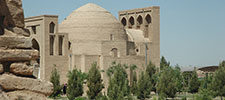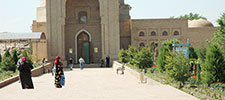The mausoleum of Hakim at Termezi
The mausoleum of Hakim at Termezi, one of the greatest of Central Asian hadith sholars, is a major pilgrimage site. Founded according to some experts in the ninth century under the dynasty of the Symanids, and gradually enlarged over a period of time until the fifteenth century, the buildings is composed of the mausoleum itself-a small domed building -with a three-domed mosque, a square courtyard and a large, domed khanaka. It contains carved brick inscriptions dating from the Karakhanid period (eleventh century) and a Timurid period senotaph.
Medieval Uzbekistan gave the world many eminent people. Among them was Isa Mahammad ibn Savra ibn Musa ad-Dahhak as-Sulami, known in Islamic world as Imam At-Termezi. He was the founder of the Sufi order Hakimi - "the order of the wise men", and he went down in history as an outstanding sage muhaddis.
At-Termezi was born in 824 CE in a small village of Bus near Termez. It must be noted that in the 9th century Termez, along with Samarkand and Bukhara, was one of the largest Islamic centers of science and culture. At-Termezi wrote over 30 books. His "Great Collection" made him especially famous. Already during At-Termezi's lifetime it was translated from Arabic into Persian and Old Uzbek. The book contains 408 hadiths. In lively literary style they tell about the personal life, habits, nature and ".. even the appearance of Mohammed the Prophet. In the gth century they built an adobe four-dome Sufi shelter hanaka on the ruins of the ancient temple. Surviving today is the large yard of this hanaka, surrounded by thick adobe walls, and the semi-basement Sufi cell hudjra, where, as it is believed, at-Termezi lived, prayed and Conversed with his myurids — students. It was then that eminent scholar and philosopher got his nickname Hakim at-Termezi - "Sage from Termez".
After his death in 892, he was buried in the yard of his hanaka. In the nth century there was built a mausoleum over the grave of the imam, with its entrance overlooking the south, and a chillyakhona structure adjoining the main construction. At first the mausoleum was a modest domed structure with a plain, even an ascetic interior; only the dome was decorated with gunch stucco carvings which have survived to the present day. At the end of the 14th century, when the region became part of Amir Temur's Empire, a new mausoleum was built next to the facade of the old one, and a magnificent white marble gravestone sagana was installed over the grave of the saint. This gravestone can be considered the real masterpiece of decorative stone carving art. Near the mausoleum there was built a commemorative ayvan mosque. Early in the 15th century a large Sufi shelter hanaka with a spacious hall for Sufi mystic assemblies was built there, too.



